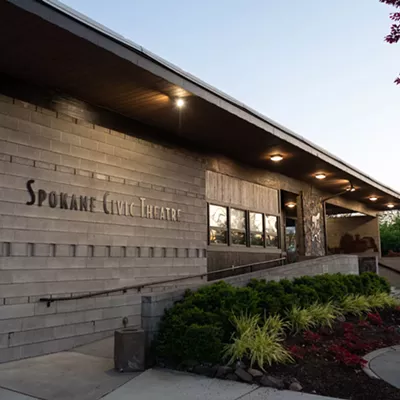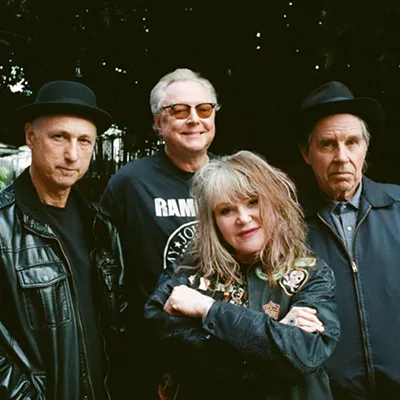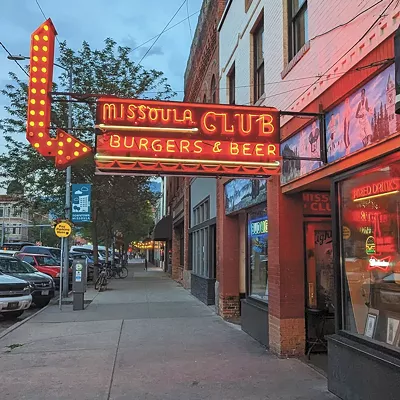
The bullet hole in the rusted-out car wheel isn't huge. It would be easy to miss if it weren't for the white tag attached, dated August 3, 2000: "Admitted In Evidence."
The holes in a piece of plywood next to the wheel are more obvious. Partly that's because there are more than two dozen of them. But mostly because of the photo of a black man and white woman in the middle that's been torn to shreds by gunplay. An undamaged copy of the same photo is attached below, along with the message: "For bi-racial marriage, the sentence is death."
Both the wheel and the ad hoc target are part of an exhibit of artifacts, including racist recruitment flyers and swastika-festooned flags, from the Aryan Nations compound on display through the end of September at Coeur d'Alene's Human Rights Education Institute, along with a series of interpretive panels explaining how the North Idaho community rallied to counteract the racist group's activities for decades. The people who put the show together are part of the same group of activists who battled Aryan Nations leader Richard Butler, his white-supremacist ideology and his often violent followers for years before successfully shutting down the group's compound in 2000.
"Some people say let it go and forget about it, but that's a terrible mistake," says Tony Stewart, one of the founding members of the Kootenai County Task Force on Human Relations and a longtime political science professor at North Idaho College. "Just like the Holocaust Museum in D.C. or the Wiesenthal Center in Los Angeles, you need historical perspective to teach new generations what happened. There are a lot of young people now who weren't even born [when the Aryan Nations was active in the area], so we need to teach them what hate was like and how it can happen. And this exhibit is a demonstration of a triumph and victory over hate by the community. That in the end, hate does not win."

The victory of the task force came after years of engagement by civil-rights-minded community members — peaceful engagement on their part, primarily through counterdemonstrations and media outreach — and the racists based at the Hayden compound.
Butler operated two groups out of the 20-acre plot. The Aryan Nations was the "political" arm that would disseminate propaganda and march on occasion, while he also held services as a religious leader for what he called "The Church of Jesus Christ Christian." Butler, who died in 2004, called for a "white homeland" in the Pacific Northwest, and pushed his ideas through his weekly church services, by providing housing for disciples of his neo-Nazi ideas, in hosting large-scale gatherings at his compound and holding parades in Coeur d'Alene. Media outlets near and far couldn't resist writing about this bizarre outpost of antiquated bigotry, and Butler was a leading voice of the white supremacist movement as a result, even if not a particularly eloquent one.
Far from being just a peaceful, hate-filled rube, Butler and his charges engaged in vandalism, bombings, robbery, even murder, through the years. That eventually led to the Aryan Nations' demise, when in 1998 some members at the compound shot at a passing car, a Honda Honeybee holding Victoria Keenan and her 19-year-old son. The car wheel in the exhibit comes from the Keenans' car, which was forced off the road by gunshots before the mother and son were assaulted and threatened. A couple of days after the attack, Keenan contacted Stewart at the Kootenai County Task Force on Human Relations, and he got in touch with local attorney and civil-rights advocate Norm Gissel.
"With five rifle shots into a Honeybee, it's hard to hit it five times without hitting a passenger," says Gissel, who worked with the Southern Poverty Law Center on the case that saw the Keenans awarded $6.3 million from Butler's organization, effectively shutting down the Aryan Nations and eventually putting the compound in the hands of the task force.
"We worked all these years, and we never had the right case," Stewart recalls. "But after Victoria came to see me, I told Norm, 'You're going to see her, and this is the one that's going to bring [Butler] down."
The exhibit includes about 140 pieces that Stewart, Gissel and others kept from the compound for educational purposes, before its buildings were burned down (as a firefighter and fire investigator training exercise) to form a "peace park." There's evidence of Butler's obsession with Adolf Hitler — a whole room at the compound was dedicated to the Nazi leader — as well as racist banners and Nazi flags. The exhibit includes shots of one building with a giant swastika painted on the roof for any surveillance planes to see. Norm recalls a food outlet at the compound where "they had Nazi Burgers for $2.25, $2.50," and laughs as he mentions taking from Butler's office a reverently hung picture of disgraced televangelist Tammy Faye Bakker.
"When we took over the compound, it was a very eerie thing," Stewart says. "There was a poster of the Twin Towers in New York, and it shows the towers going up in smoke and flames and it said, 'Burn Jew City.' That poster was from two years before it happened, 1999."
It's also part of the exhibit which Stewart hopes will teach people that hate can happen anywhere without vigilance. He and Gissel have traveled extensively to talk about their experiences, and both are aware that even though the Aryan Nations is gone, there are still locals who believe in its hateful ideology.
They hope this exhibit can serve as a needed history lesson for the young, and a stark reminder to those old enough to remember Aryan Nations bombs going off at churches, courthouses and businesses in Coeur d'Alene.
"That's the reason for doing this, to keep the dialogue going," Stewart says. "Say 'no' and stand up when hate rears its head in your community or in your country." ♦
Aryan Nations exhibit • Through Sept. 30: Mon-Fri, 10 am-5 pm; Sat, 10 am-2 pm • Human Rights Education Institute • 414 W. Mullan Rd., Coeur d'Alene • hrei.org • 208-292-2359























